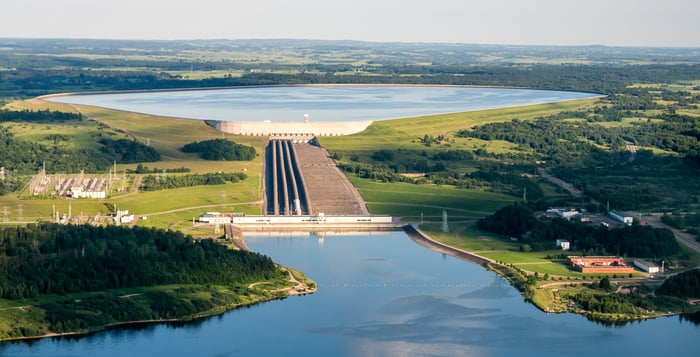Solar and Wind Power Can Now Compete with Fossil Fuels

There is a common misconception that renewable sources are expensive, while fossil fuel generation is cheap. That was only true one decade ago, however, and there are now solar and wind power projects that can beat the electricity cost of coal. In spite of that, renewable sources still have a key challenge to overcome - their dependence on variable energy inputs.
The cost comparison between renewable sources and fossil fuels is often unfair, since the output of new renewable projects is compared with that of existing coal or gas generation. Consider that new projects have financing to cover, while older power plants are only burdened with operation and maintenance. When renewable sources and fossil fuels are compared for a new generation project, renewables often emerge as the most affordable option.
Reduce building power bills and emissions with renewable energy.
The Remaining Service Life of Existing Fossil Fuel Generation
As mentioned above, new renewable energy projects often compete with fossil fuel generation systems that are already decades old. As a result, project financing has already been paid and investors have already earned most of their expected profit. These power plants can continue delivering cheap electricity for their remaining service life, but they will eventually be decommissioned.
Many coal-fired power plants will reach the end of their service life in the next decades, and building new ones is unlikely to be an attractive investment. New fossil fuel generation must not only compete with cheap renewable energy; there may also be public backlash due to the environmental impact.
Fossil fuels still have an advantage over solar and wind power: a reliable electricity output that is not bound to the variability of sunlight and wind. However, variable production can be compensated with demand response and energy storage systems.
Advantages of Shaping Electricity Demand
The traditional operation of power companies has been adjusting production according to demand, which leaves plenty of generation and transmission capacity idle during low-demand periods. However, unused capacity still has ownership costs, which are reflected in power bills. In other words, idle capacity has a negative effect on both utility companies and consumers.
Since peaks in electricity demand are expensive and technically challenging, power companies follow two main strategies: increasing kWh prices when overall demand is high, and applying capacity charges to the individual demand peaks of large consumers.
- This system is designed to penalize consumers who don’t control their demand peaks, but it also represents a savings opportunity for those who manage their consumption.
- If peak kWh rates are avoided and individual demand peaks are minimized, consumers can reduce their power bills - even if total energy consumption stays the same.
Automation can be very useful for shaping electricity demand. For example, smart thermostats can be programmed to minimize compressor runtime when the local power company is applying the highest kWh rates. If the concept is deployed in many buildings, their cumulative effect can drastically reduce the network load. Since transmission and distribution losses have a quadratic relationship with current, demand response can also make the electricity grid more efficient.
Demand response systems can achieve synergy with renewable generation, by following the opposite approach. When there is an abundance of low-cost generation from solar arrays and wind turbines, two approaches can maximize the value of that energy:
- Scheduling activities that are not time-sensitive at hours when cheap electricity from variable renewable sources is abundant.
- Building owners with energy storage systems can fill up their capacity with low-cost electricity that is emissions-free.
Energy Storage and Variable Renewable Generation
Energy storage has made headlines thanks to its promising applications, even when high costs still limit its opportunities. The concept of energy storage is commonly associated with batteries, but it is important to note that other forms of storage exist. Actually, most of the energy storage capacity in the world is in the form of pumped-storage hydroelectric facilities (PSH), rather than battery arrays.

Heat storage and ice storage are also viable in some applications. For example, storing electricity in battery arrays to drive a chiller plant has a prohibitive cost, but consider that the requirement is to provide cooling. A smarter approach is adding ice storage tanks to the chiller plant, where ice can be melted to provide cooling without increasing power demand.
Hot water storage is also viable for direct use or for space heating with fan coils. In applications that require a higher heat output than what hot water can provide, molten salt can be stored in refractory tanks.
Regardless of the energy storage method chosen, there is potential synergy with variable renewable sources. Traditionally, generation and consumption have occurred simultaneously, but demand response and energy storage can eliminate this constraint.

Michael Tobias
Michael Tobias, the Founding Principal of NY Engineers, currently leads a team of 150+ MEP/FP engineers and has led over 4,000 projects in the US
Join 15,000+ Fellow Architects and Contractors
Get expert engineering tips straight to your inbox. Subscribe to the NY Engineers Blog below.

